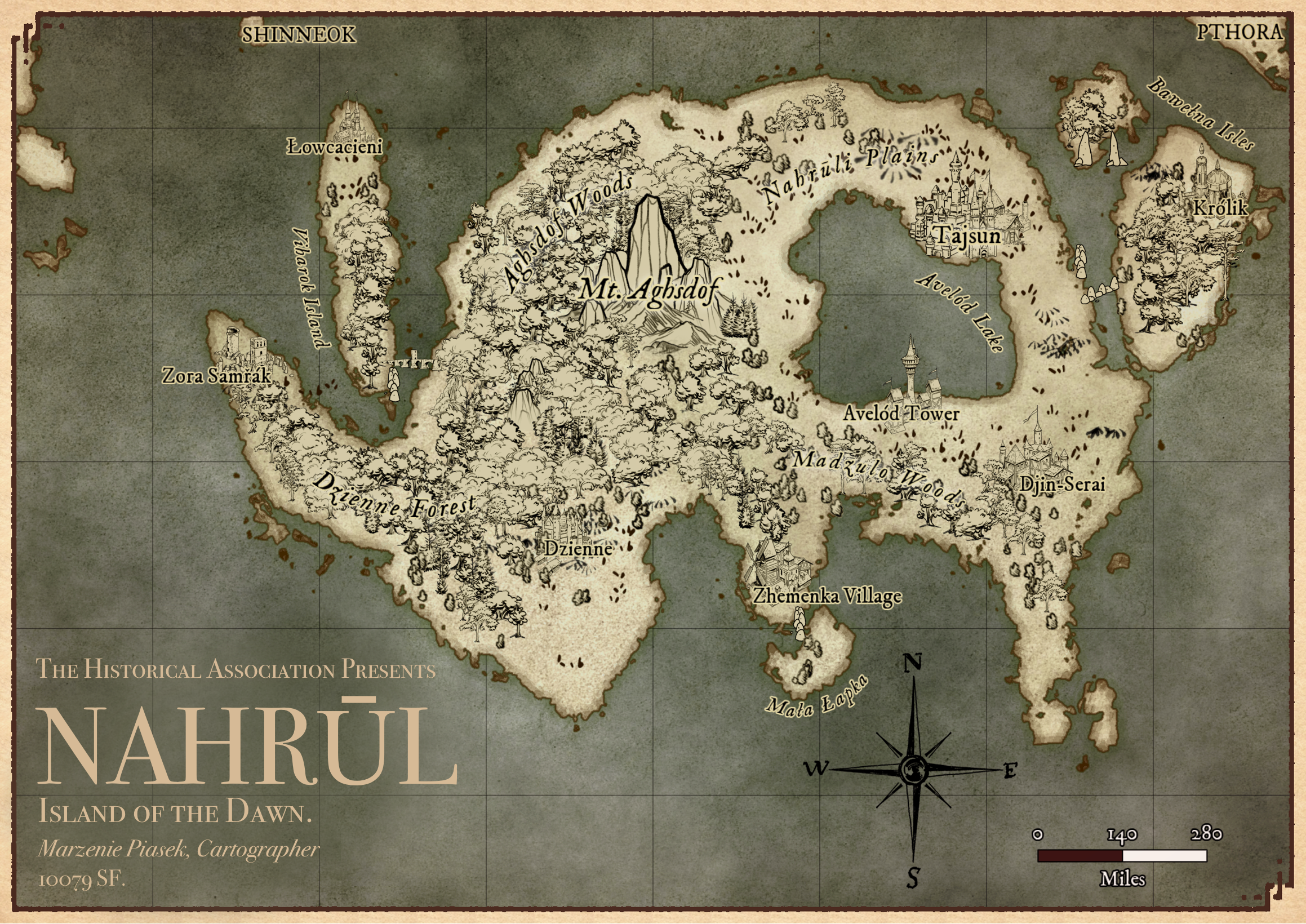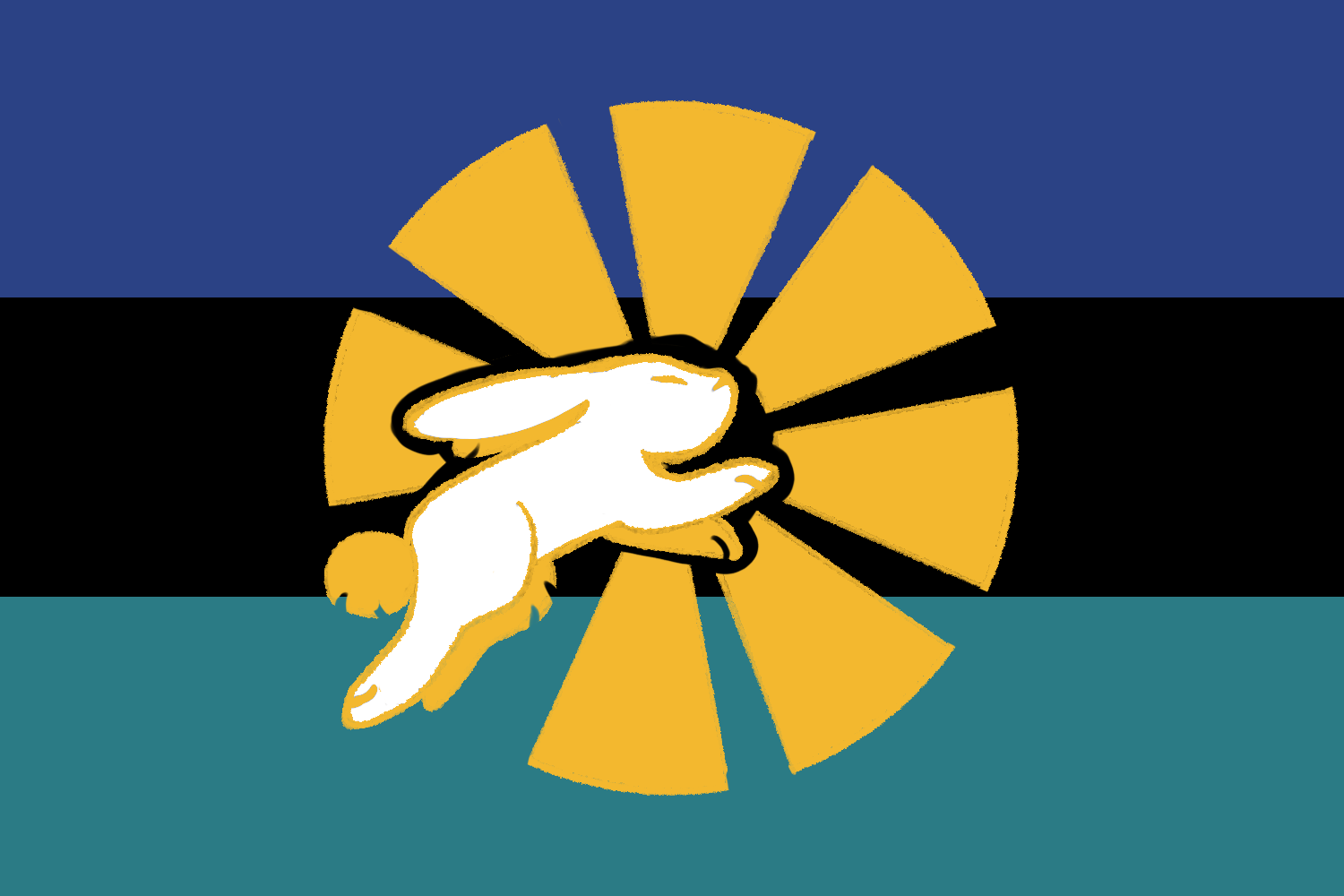Table of Contents
Nahrūl
- Government Type: Theocracy
- Symbol: Rabbit
- Major Races: Humans, Dwarves
- Capital: Tajsun
- Demonym: Nahrūli
Not far from the frozen lands of Pthora is the volcanic island of Nahrūl, its lands borne from the fury of the volcano Mt. Aghsdof. It is a smallish island nation, with the land and its surrounding waters kept relatively warm by the magma beneath. From above, the land resembles a leaping rabbit; this has given rise to quite a few superstitions and legends, and plays a part in Nahrūli national symbology.
Touched by the blight of beings from beyond Cahyali, Nahrūl is a land marked by its resilience in the face of hardship and its ever fervent battles against monsters to restore peace to its shores. Living in a constant cycle of holy wars, Nahrūl today is still recovering from the brief reign of the Nightmare King, a tyrant of dark magic who left the nation plagued with darkness in the countryside. Monster hunting has become a popular trade, and blacksmiths who can work with monster parts are commonplace.
Through all of the darkness, there has been one true organized force of order amidst the seas of chaos, the Lamplighters of the Church of Peregrinus (Ra). Bringing light to the realm, the Lamplighters’ mission is to restore Nahrūl to a state of peace free from the influence of the Nightmare King and the Church of Night once and for all.
For more information on the history and culture of Nahrūl, follow this link: Nahrūl History & Overview
Regions
Due to its small size, Nahrūl is very similar in terms of climate across its entire land. However, most of the citizens split the country about in half east to west, making a stark distinction between the eastern and western lands.
Eastern "Lightlands"
Centralized around the Avelód Lake, this half of the country is where most of the (living) population resides, and where Ra'ite temples do most of their work. Lightlanders fear the west of the island, and simultaneously tremble under the encroaching threat of Pthora further to the east.
Western "Shadowlands"
Under the literal shadow of Mount Aghsdof, this half of Nahrūl is haunted by the actions of the Nightmare King and by the footprints and claw marks of terrible monsters prowling the wilds. Most settlements here are populated mainly by gruff, monster-hunting types, or by monstrous folk such as sentient undead. Shadowlanders often hold grudges against easterners, believing them to be cowardly fools too paralyzed by fear to help their own people.
Laws
Policing in Nahrūl is not too strict, with most enforcers of the law also being Lamplighters. Most of their efforts are focused on chasing down monsters, however, as opposed to people. It is not uncommon to be able to get away with quite a bit of crime before the law takes notice.
- Theft; Any Kind: Minimum fine of double the cost of the item stolen
- Assault; Any Kind: Minimum incarceration of 5 years, potential for fines
- Murder or Rape: Minimum incarceration of 20 years
- Heretical Worship; Including worship of Tenebrus, demons, fey, or other entities: Life incarceration
- Membership in the Church of Night: Life incarceration
- Destruction of Public Facilities: Minimum 1 year incarceration and 1 year community service
- Prohibiting or hindering someone’s basic rights given by the government: Minimum fine of a month’s wage of the accused and potential incarceration
- Ownership of another intelligent being: Life incarceration
The national flag of Nahrūl.
Cities of Nahrūl
Tajsun: The first and oldest city of Nahrūl, Tajsun is the capital and home to both the Church of Peregrinus and the Lamplighters. Protected by ancient dwarven walls, Tajsun shines as a beacon of hope for those in the countryside on the northeastern shores of Avelód Lake.
Tajsun is the only city with functioning public infrastructure in Nahrūl on par with the rest of the world due to the focus from the Church of Peregrinus and the noble families within its walls, as well as craftsmanship from ancient dwarvish settlers.
Avelód Tower: On the southern shores of Avelód Lake sits the famed Avelód Tower, a holy pilgrimage site for Priests of Peregrinus and is the place where Lamplighters are trained and ordained. This tower was in the past and still is a strategic lynchpin in the Church of Peregrinus’ wars against the Church of Night.
Djin-Serai: A city ravaged by the reign of the Nightmare King that is now on the mend. Having reestablished connection with the city of Tajsun, Djin-Serai has become a rather successful logging community, venturing out into the forests to collect lumber to trade with Tajsun and other nearby settlements.
However, the memories of the Nightmare King are still fresh in the memories of its residents, and the wound still seems to fester as monsters and ghouls still plague the village, making it an important barracks city for Lamplighters.
Królik: Located on the far eastern border of the country, Królik is a prolific port town that primarily deals in trade going to and from Pthora, though occasionally it does see foot traffic from Ley’Ork and other eastern nations. Due to its location near the border, it is also a common stop for undead seeking asylum in other eastern nations.
Zhemenka Village: A small village on the southern border of Nahrūl that is known for its healers. Founded by a priestess of Peregrinus long ago, Zhemenka is a place known for being able to heal even the deadliest of illnesses, and is said to be a place of miracles.
In the center of the village is a large combination hospital convent run by Peregrinites, and it sees constant foot traffic not only from the local residents, but even from foreign nations due to its location on the southern shores.
Dzienne: A dwarvish village in southwestern Nahrūl. This is a city of blacksmiths and forges, where creators of all kinds gather to share their arts with the world. This is the primary city where monstrous items are formed out of the remains of dead monsters that adventurers have taken trophies from. From armor made with the silk of a giant spider to a dagger forged from a chimera’s fangs, the blacksmiths of Dzienne are remarkably skilled at turning natural elements into weapons, armor, and items.
Zora Samřák: Located on the far western side of Nahrūl, Zora Samřák is a door to the rest of the world. Zora Samřák is a city of ruins, and is theorized by local historians to be the location of the first Church of Night before it was initially destroyed by the Church of Light during the first holy war.
Zora Samřák is a vibrant trading city with business being done with Ulos and Dahabu especially. As such, Zora Samřák is also the home of the magic school of Nahrūl where young mages can learn from Ulosian and Dahabi arcane scholars about their arts.
Łowcacieni: A small village on the northwestern border of the country. Łowcacieni is a village of monster hunters, and is famed for its hardy people and harsh environment, being located in the middle of a wasteland. Being located on the northern shore, Łowcacieni is also a trading port, dealing in items coming in from Shinneok.
Despite its proximity to Shinneok, Łowcacieni is almost never traveled by undead seeking asylum in its borders due to the lack of oversight in the region, making it one of the few places in Nahrūl without direct oversight from the Church of Peregrinus.
Culture
The land of Nahrūl is heavily scarred by the Nightmare King's reign. Before his attack, it was a rather peaceful place, full of its own superstitions and small magics but overall thriving. After the Nightmare King, however, Nahrūl was forever changed. Monsters now roam the lands, and foreign threats are forever present.
Nahrūli citizens are often suspicious of outsiders, fearing that newcomers to their towns may be hostile foreign agents or even monsters in disguise. However, anyone proving themselves to truly be on the side of the people will earn themselves a hero's welcome that spreads like wildfire between the cities. Those who take up the trade of monster hunting and undead slaying are well respected, and adventurers generally have a positive reputation in Nahrūl.
Nahrūli Names
Uniquely amongst Cahyali, Nahrūli last names are not family signifiers. Instead, all citizens take the last name “Nahrūli” until they come of age and begin to work, at which point they change their last name to something related to their occupation. For example, Rolnik for a farmer, or Kovář for a blacksmith. People working in the public sector, such as for the government or certain temples, keep the Nahrūli surname.
Family names amongst Nahrūli are their middle names, and are passed down maternally. Many last names end with the suffix -vich. First names are given, the same way as the rest of Cahyali.
The Lamplighters
The image of a lit lamp is a symbol of hope for Nahrūli citizens, as it is the symbol of the Lamplighters Guild, a sect of the Church of Peregrinus dedicated to fighting against the Church of Night and the monsters of the land.
As a sect of the Church of Peregrinus, the Lamplighters act as the enforcers of the land ensuring that order and tranquility is maintained. It is their sworn duty to bring an end to the Church of Night. They carry about sun sculpted lighters to ignite the lamps of the cities with holy sunlight to keep creatures of darkness away; this has become an easily identifiable mark.
The Church of Night
Less an organized religion and more a loose collective of people with similar goals, the Church of Night is composed of Tenebrus priests, practitioners of dark magic, and those who seek to sow chaos in the world.
A majority of the monsters found in modern Nahrūl are due to either summonings or dark experiments performed by the Church of Night. Members of the Church often operate in secret, and there is no longer a single location that members can look to and call their headquarters. Meetings are often held in secret either outside or within the borders of cities. The only time that the Church seems to hold an organized effort is during the times when Aghsdof erupts, spewing smoke into the sky and shrouding the land in darkness.
Members seem to revere darkness as a transformative force used to bring balance to the excess of order produced by the Church of Peregrinus, ensuring light doesn’t overwhelm the land and reduce it to stagnancy.

